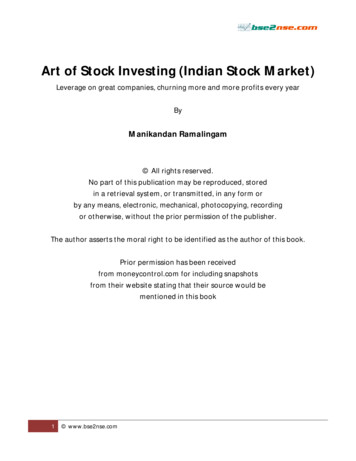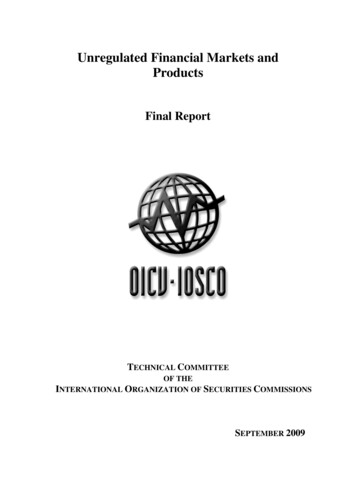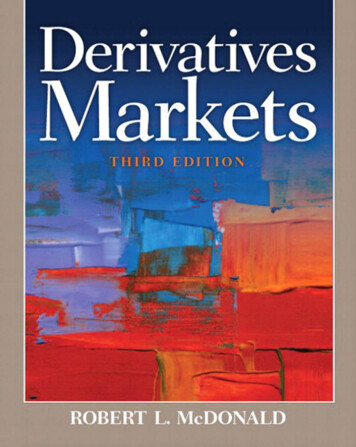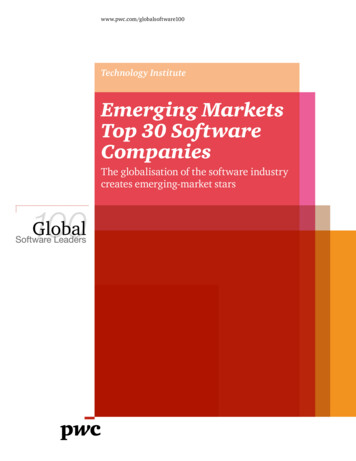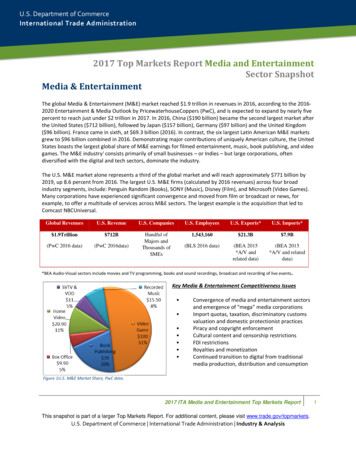
Transcription
U.S. Department of CommerceInternational Trade Administration2017 Top Markets Report Media and EntertainmentSector SnapshotMedia & EntertainmentThe global Media & Entertainment (M&E) market reached 1.9 trillion in revenues in 2016, according to the 20162020 Entertainment & Media Outlook by PricewaterhouseCoppers (PwC), and is expected to expand by nearly fivepercent to reach just under 2 trillion in 2017. In 2016, China ( 190 billion) became the second largest market afterthe United States ( 712 billion), followed by Japan ( 157 billion), Germany ( 97 billion) and the United Kingdom( 96 billion). France came in sixth, at 69.3 billion (2016). In contrast, the six largest Latin American M&E marketsgrew to 96 billion combined in 2016. Demonstrating major contributions of uniquely American culture, the UnitedStates boasts the largest global share of M&E earnings for filmed entertainment, music, book publishing, and videogames. The M&E industry i consists primarily of small businesses – or Indies – but large corporations, oftendiversified with the digital and tech sectors, dominate the industry.The U.S. M&E market alone represents a third of the global market and will reach approximately 771 billion by2019, up 8.6 percent from 2016. The largest U.S. M&E firms (calculated by 2016 revenues) across four broadindustry segments, include: Penguin Random (Books), SONY (Music), Disney (Film), and Microsoft (Video Games).Many corporations have experienced significant convergence and moved from film or broadcast or news, forexample, to offer a multitude of services across M&E sectors. The largest example is the acquisition that led toComcast NBCUniversal.Global RevenuesU.S. RevenueU.S. CompaniesU.S. EmployeesU.S. Exports*U.S. Imports* 1.9Trillion 712B1,543,160 21.3B 7.9B(PwC 2016 data)(PwC 2016data)Handful ofMajors andThousands ofSMEs(BLS 2016 data)(BEA 2015*A/V andrelated data)(BEA 2015*A/V and relateddata)*BEA Audio-Visual sectors include movies and TV programming, books and sound recordings, broadcast and recording of live events.Key Media & Entertainment Competitiveness Issues Convergence of media and entertainment sectorsand emergence of “mega” media corporationsImport quotas, taxation, discriminatory customsvaluation and domestic protectionist practicesPiracy and copyright enforcementCultural content and censorship restrictionsFDI restrictionsRoyalties and monetizationContinued transition to digital from traditionalmedia production, distribution and consumptionFigure 1U.S. M&E Market Share, PwC data.2017 ITA Media and Entertainment Top Markets ReportThis snapshot is part of a larger Top Markets Report. For additional content, please visit www.trade.gov/topmarkets.U.S. Department of Commerce International Trade Administration Industry & Analysis1
Media & Entertainment Sectors as Major Economic DriversIn 2015 (the latest available data), the value added by core copyright industries to U.S. GDP reached more than 1.2 trillion, accounting for 6.9 percent of the U.S. economy. From 2012-2015, core copyright industries grew anaggregated annual rate of 4.8 percent, a whopping 127 percent more than the entire U.S. economy, which grew atonly a 2.1 percent rate. In addition, the average annual 2015 compensation was 93,221 for workers in the corecopyright industries, which far exceeds the average compensation paid to all U.S. workers, 67,715.U.S. copyright industries contribute significantly to exports and outperform other sectors. For example, select U.S.copyright products in overseas markets amounted to 177 billion in 2015 (IIPA Report), which represents asignificant increase over prior years’ exports. M&E sectors had higher exports in comparison to other sectors, suchas chemicals ( 135.8 billion), aerospace products and parts ( 134.6 billion), agricultural products ( 62.9 billion),and pharmaceuticals ( 58.3 billion). Industry leaders work hard to articulate the impact of core copyrightindustries on the U.S. economy to garner government support. While traditional M&E sectors (such as hardcopybooks, CDs and vinyl, film reels, analog broadcast and video game consoles) are still in circulation, growth ishappening primarily in digital sectors.Key Trends in Media & Entertainment for 2017 Convergence of industry and cord cutting – and – consumer as creator and industry driverInteractive devices and tech drivers – yet industry is still largely analoguePersistent piracy and lack of strong enforcement of copyright lawsLeading sectors include: augmented and virtual reality, eSports, streaming and video: OTT/VOD, andmultichannel networksBesides convergence, which can consolidate power in tothe hands of a few major corporations, the industry is stillevolving from a physical marketplace to a digital economywhere consumers create and publish content, and driveindustry executive-decision making. Consumers alsodemand increasingly sophisticated tools to access content,and technology is a big player and enabler for M&E sectors.Digital trade has brought attention to widespread piracyand the importance of having solid copyright laws andenforcement actions, along with educational campaigns toencourage legal consumption of M&E. Despite the digitalevolution, segments of the M&E industry still linger in thephysical realm, such as in book publishing, newspapers(especially in foreign markets), and the music industry.Video games and consoles are still very popular and affordable overseas. Virtual Reality (VR) and AugmentedReality (AR) permeate nearly all M&E sectors and have been the fastest growing of the sectors discussed here. Notonly is VR the hottest word in the world of entertainment, but VR offers lifesaving applications in health care andinnovative solutions in education, as well as across other sectors. eSports has become a global phenomenon and isexpected to surpass 500 million in 2017, and could reach 1.9 billion in 2018, according to Fortune.com.Along with convergence, multichannel networks (MCNs) and cord cutting have affected business and consumerchoices about how, when, and what entertainment to consume. MCNs work with video platforms to help videochannel owners create, fund, promote and sell digital content in exchange for advertising revenues. Cord cutters,consumers preferring wireless devices over land lines, have disconnected cable services and use smart phones.These market disrupters have led to new challenges in domestic and foreign markets, as well as new opportunities.2017 ITA Media and Entertainment Top Markets ReportThis snapshot is part of a larger Top Markets Report. For additional content, please visit www.trade.gov/topmarkets.U.S. Department of Commerce International Trade Administration Industry & Analysis2
Piracy and illegal file sharing continue to plague the M&E sectors. It is difficult to quantify losses from piracy and tocalculate piracy rates accurately. Therefore many industry groups and businesses track piracy around the clock,and online takedown notices are rising dramatically as a result. From current research on internet traffic andrequests for takedowns, one can estimate revenue losses from digital and copyright theft to range in the millionsof dollars. The Copyright Industries in the U.S. Economy: The 2016 Report, by Economist Stephen E. Siwek, andpublished in cooperation with the International Intellectual Property Alliance (IIPA), defines core copyrightindustries as “those industries whose primary purpose is to create, produce, distribute, or exhibit copyrightmaterials. They also provide significant value added to GDP; an increasing number of high-paying jobs; real growthwhich outpaces the rest of the economy; and substantial foreign sales and exports, surpassing many industrysectors.”Top 10 Media & Entertainment Companies iiComcast Corporation 68.7BDisney (USA) 52.5BWanda Group (China) 37.5BDirectTV (USA) 30BTime Warner (USA) 30B21st Century Fox (USA) 28.9BDish Network (USA) 14.6BCBS (USA) 13.8BViacom (USA) 13.8BNetflix (USA) 8.8BAs a world leader in innovation, U.S.companies rely on IP-intensive industriesthat continue to be an important andintegral part of the U.S. economy thataccounts for more jobs and a largershare of U.S. gross domestic product(GDP).“Intellectual Property and the U.S. Economy: 2016 Update”(USPTO), U.S. Department of CommerceKey Global Media & Entertainment Export & Licensing Markets – Snapshot of the Top Five Countries in 2017The following country insights cover the top five export and licensing markets for U.S. digital and creative sectors,as found in the 2016 Top Markets for Media & Entertainment report, with updated 2017 data. iii1. The United Kingdom is a robust M&E marketplace with steady, reliable growth across the sectors, and relativelyfewer trade barriers. It is expected to grow 3.4 percent from 2016-2017, to reach 99.8 billion. As an Englishspeaking country, it is an easy marketplace for American exporters to navigate and content travels easily. Keygrowth sectors include: e-books; especially in the education sector, the digital music sector, over-the-top (OTT)streaming (i.e. entertainment content such as audio, video, and media transmitted over the internet, including;video on demand (VOD) and streaming video to TV (SVTV), broadcast and satellite television, and video games;including PC, app-based, digital, as well as online consoles. NOTE: the impact of Brexit is unclear, although M&Efirms will have to stay abreast of potential changes to copyright and data transfer laws, licensing regulations anddistribution rights, and subsidies and production quotas for the industry. iv2. China‘s 209 billion market grew just under 10 percent from 2016- 2017, a slight decline from 2015. Althoughmarket size and potential is unmatched, serious barriers to entry persist due to censorship rules on culturalcontent sectors, including internet, TV, film, music, radio, text messaging, games, newspapers, books and printmedia; as well as significant import restrictions, FDI caps, and co‐production requirements. China’s growingaffluent consumer base seeks quality entertainment and content, and U.S. M&E products and services are in highdemand. The Chinese government has invested immensely in to the industry and businesses are eager to realizejoint business deals and learn from U.S. technical and intellectual know-how. Key growth sectors include: e-books,filmed entertainment, live music/concerts, and digital music streaming, electronic home video, especially OTTstreaming; and video games, such as PC, app-based digital and online games, and consoles.3. Canada’s M&E marketplace is expected to reach 45.3 billion in 2017, an overall growth rate of 3.6 percentwhich is consistent with the country’s prior growth. Canada has a well‐developed professional sector that makestrading easier and efficient for U.S. exporters. However, there are copyright and other trade barriers for Americanbusinesses in Canada. Online infringement is high and enforcement weaker than expected. Reports of illegal2017 ITA Media and Entertainment Top Markets ReportThis snapshot is part of a larger Top Markets Report. For additional content, please visit www.trade.gov/topmarkets.U.S. Department of Commerce International Trade Administration Industry & Analysis3
retransmissions of certain TV programming and unfair discrimination against music performance, act as barriers,but U.S. businesses have many opportunities in this sophisticated market. Key growth sectors include: digital musicstreaming, e-books, satellite radio advertising, and video games, including PC, app-based, digital, and online gamesand consoles.4. India offers a growing middle class of high‐tech savvy consumers and vibrant media, entertainment andinnovation sectors. It is a very challenging marketplace, with barriers, to trade such as high piracy threats to bothphysical and digital M&E sectors, and uncertain implementation of laws governing the M&E sectors. The IIPAreports online and mobile piracy, illegal file sharing of music, cam cording in theaters, and rampant signal piracy ofpay TV content. Nonetheless, the M&E market grew 11.4 percent to reach 32.2 billion in 2017. There is robustgrowth in educational and professional e-books, but sales of consumer e-books are skyrocketing in India (includingin English and many regional Indian languages). There is also steady growth in consumer and professional print andaudio books; one of the few markets where hardcopies are still in demand. The movie industry in India is bigbusiness and box office revenues are growing steadily. The best opportunities for U.S. businesses, however, aremore likely found in joint “Bollywood” production projects, rather than in licensing or exporting movies. Electronichome video is expanding rapidly, especially streaming content for a monthly flat rate. The all-inclusive, unlimitedsubscription model is gaining in popularity as digital entertainment expands in India just like in many developingeconomies. Live music and digital music streaming are proliferating in India. Video games, including PC, appbased, digital, and online consoles are also growing rapidly.5. Brazil’s M&E market grew 6.3 percent to reach 41.7 billion in 2017, despite a challenging year. Brazil is adesirable but somewhat troubled market for U.S. M&E firms. It is a large and growing marketplace, withremarkably difficult business practices, numerous barriers to trade, and very high taxation on foreign M&Eproviders. For example, Brazil’s audiovisual regulatory environment is complex and favors national content andproduction. Copyright industries doing business in Brazil face significant Internet piracy, as do products in theentertainment sector, such as CDs; DVDs; and other media carrying pirated music, movies, TV programming andvideo games. Circumvention devices that allow access to video game consoles are a problem for all copyrightsectors. The activity is driven by high costs and taxes on entertainment and lack of a full catalogue offering to thepublic, some of which is a governmental problem, and some of which is caused by the industry. Problems withenforcement for illegal downloads are being addressed in a pending and long‐awaited new copyright law. U.S.content and industry know‐how are in very high demand. Key growth sectors include: e-books, especially in theeducational sector, movies and box office, live music and digital music streaming. While these are growth areas, itis important to note that they represent a smaller portion of the market. OTT streaming is very strong, althoughother TV segments are in decline. Finally, video games, including PC, app-based, digital, online, and consoles aregrowing.Key Media & Entertainment Industry Partners American Association of Independent Music (A2IM)American Association of Publishers (AAP)American Society of Composers, Authors and Publishers(ASCAP)Copyright Alliance (CA)Digital Entertainment Wire (DEW)Entertainment Software Association (ESA)Independent Film and Television Alliance (IFTA) International Intellectual Property Alliance (IIPA)Motion Picture Association of America (MPAA)National Association of Broadcasters (NAB)National Association of Television Program Executives(NATPE)National Endowment for the Arts (NEA)National Music Publishers’ Association (NMPA)Recording Industry Association of America (RIAA)i Themedia and entertainment sectors researched in this snapshot include the core copyright industries: books, newspapers, periodicals, motion pictures, TV production, recordedmusic, radio and television broadcasting, video games. (Software is also part of the core copyright industries).ii World’s Top 10 Entertainment Companies: s.aspiii A forthcoming report in 2018 will revisit available data and take stock of market, regulatory and industry changes that have transpired. An in-depth review and lengthymethodology analysis of twenty-five global M&E markets is required to determine which countries rise to the level of top market status and this snapshot is meant to provide a briefupdate on current trends (ranked in order of the 2016 Top Markets Report).2017 ITA Media and Entertainment Top Markets ReportThis snapshot is part of a larger Top Markets Report. For additional content, please visit www.trade.gov/topmarkets.U.S. Department of Commerce International Trade Administration Industry & Analysis4
Brexit Update Entertainment & Media 2016: -entertainment-sept-2016-update.pdf . Brexit: Impact on Media, Sport andEntertainment: nd-entertainment/. How Brexit Will Impact the EntertainmentIndustry (Guest Column): 201809355/iv2017 ITA Media and Entertainment Top Markets ReportThis snapshot is part of a larger Top Markets Report. For additional content, please visit www.trade.gov/topmarkets.U.S. Department of Commerce International Trade Administration Industry & Analysis5
U.S. Department of Commerce International Trade Administration Industry & Analysis U.S. Department of Commerce International Trade Administration . 2017 Top Markets Report Media and Entertainment . Sector Snapshot. Media & Entertainment The global Media & Entertainment (M&E) market reached 1.9 trillion in revenues in 2016, according to the .

